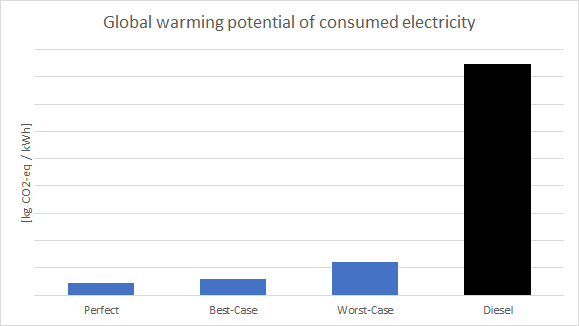Environmental impact of the Solartainer with LCA method (Life Cycle Assessment)
My name is Philipp and I studied environmental engineering at the Technical University of Darmstadt. The studies follow some years of working in the research and development of printable inorganic electronics for display applications. After having decided to reorientate I found myself learning again. Approaching the end of the degree programme I had to write a thesis. I knew that I wanted to apply the LCA method since I like the structured approach of the method as well as its clearness and have therefore set my focus on this method in previous courses. However I was less decisive on the product to be analyzed. That’s when AGT appeared in my field of vision. An announcement of AGT on the bulletin board of my college caught my attention and there we go.
In my master’s thesis I have assessed the environmental impacts of the Solartainer Amali with the aim of highlighting optimization potential and comparing it to another power generating technology.
The basic idea of LCA is the analysis of material and energy flows that are exchanged with the environment throughout a product life cycle and quantifying their impact. By relating the amount of impact to the function of a product, one can compare very different products or technologies which provide the same function. Since the flows can cause a variety of environmental impacts, the “best” product can vary between impact categories. I chose to focus on flows that contribute to global warming (like exhaust gases), flows that affect human health (like exhaust gases, particulate matter, heavy metals), flows that represent the consumption of rare-earth elements as well as energy related flows.

Life cycle of a product (https://www.sciencedirect.com/topics/earth-and-planetary-sciences/life-cycle-analysis)
The chart shows the contribution of consecutive (clockwise) life cycle stages to global warming potential. The production of initial components (like solar modules, batteries, inverter) causes more emissions than the steel structure manufacturing of the container. Further emissions are caused by the replacement of batteries and inverters during the operation of the Solartainer. Is the absolute global warming potential in kg CO2 emissions little? Is it much? This depends on the amount of electricity which can be provided by one Solartainer and be consumed.

The calculation of the consumption which will be achieved after 30 years is difficult since the annual consumption is no static number. It is developing and its increase varies between ImpactSites. At the same time the yield of the solar modules might decrease because of degradation. The Best-Case consumption surpassing the yield is considered in detailed assumptions, which aren’t deepened at this point.

In the following chart the total emissions are related to the consumption of two ImpactSites with different consumption patterns. The ‘Perfect’ represents a theoretical optimum which illustrates a complete consumption of the yield. For comparison the emissions of electricity provided by a diesel generator are displayed. The benefit of the Solartainer concerning global warming is immense.

However when looking at other impact categories, the human toxicity potential of electricity in the best-case and worst-case ranges around the human toxicity potential of the electricity provided by a diesel generator. One can argue that diesel generator emissions that affect human health probably appear where the electricity is produced which is in villages close to population whereas emissions from the Solartainer production derive from geographical scattered component production. With a weighted human toxicity potential there might be a benefit as well. The abiotic resource depletion of electricity from a diesel generator ist lower than the abiotic resource depletion of both cases.

The optimization potential was determined by varying the technology of the solar modules and the batteries as well as the orientation of the solar modules.
Multi crystalline silicon and cadmium telluride solar modules are less energy intensive in manufacturing than the single crystalline silicon solar modules used in the Solartainer. Due to lower efficiencies their yield would be lower. The energy related global warming potential of less energy intensive solar modules only pays off in the worst case, where the consumption is not limited by the yield. The global warming potential can be reduced by up to 14 %.
Other battery chemistries show lower environmental impacts in all observed categories. The most impressive reduction of environmental impact can be observed when using “2nd life batteries” from automotive application, which only hold a global warming potential due to the energy needed for 2nd life preparation. The abiotic resource depletion of the Solartainer with 2nd life batteries can be decreased by up to 35 %. The global warming potential is around 13 % lower.
When observing the daily consumption it can be detected that it occurs with a time offset to the yield of the two main orientations. I was wondering if the orientation of all solar modules to the west matched the consumption better. Although the daily yield of the west orientation is slightly lower than the yield of the east orientation, the battery state of charge in the evening is slightly higher with complete west orientation. The difference in the state of charge is insignificant and the environmental impact of this potentially higher consumption decreases to my surprise by less than one percent.

I came to the conclusion that a higher exploitation of the available yield offers a higher potential of environmental impact reduction than technical optimization. Solutions such as internet or water treatment are already implemented by AGT but have not been assessed in this study. From the life cycle perspective this opens the field of multiple output processes and raises the question of the allocation of the environmental impact of the Solartainer to its products.
Conclusion:
The LCA has revealed strengths and weaknesses of the Solartainer compared to a diesel generator. In the most significant impact category, namely global warming, there is a huge benefit, which reveals the meaning and value of the Solartainer in a carbon friendly energy supply.